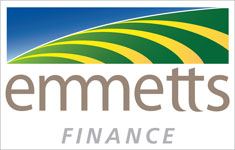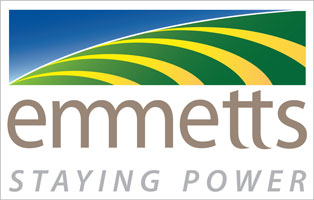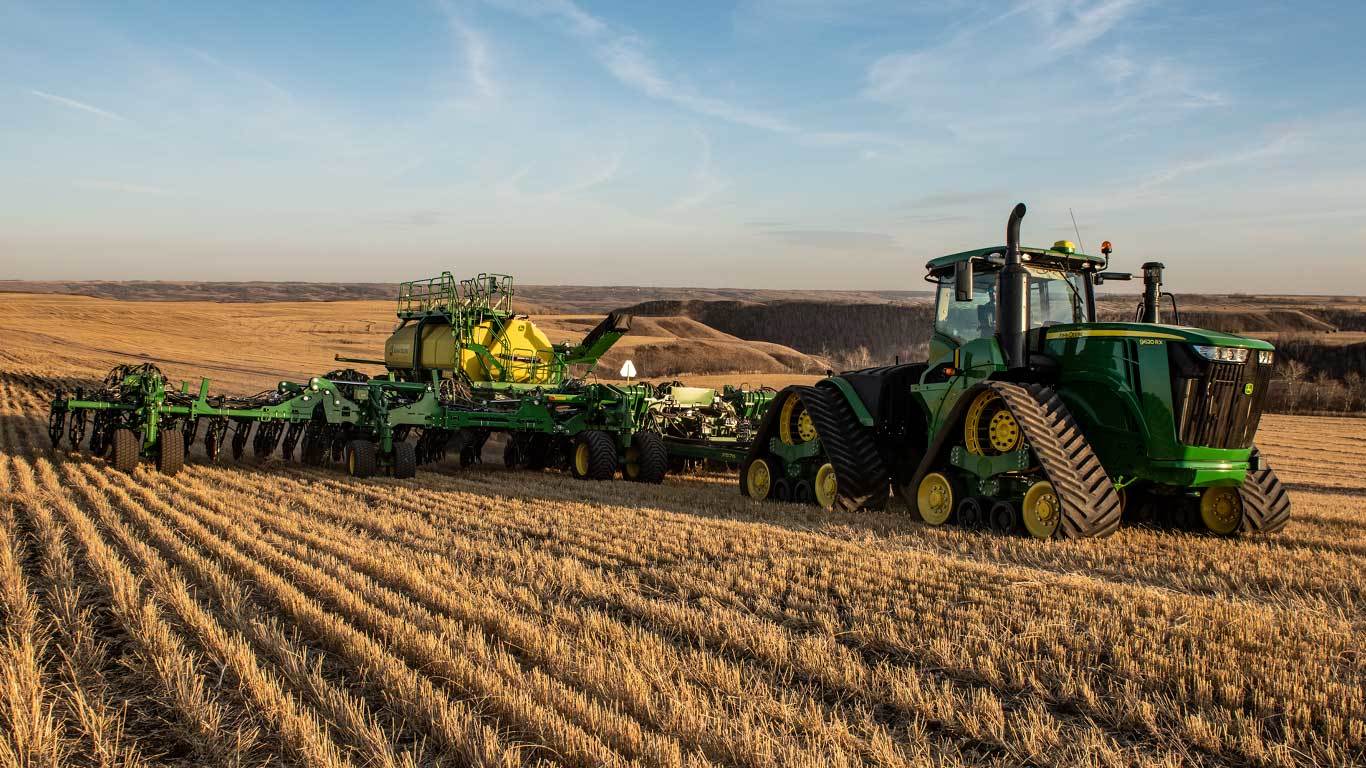
- Accurate seed placement with TruSet™ depth/pressure control
- Consistent seeding rates from row to row with RelativeFlow™ blockage monitoring
- Get in the field sooner with standard high-flotation package
- 12.2 m, 17.1 m, and 23.2 m sizes to match your needs
Features
The Total Seeding Solution – experience the John Deere advantage
John Deere has the seeding solutions that go above expectations with a complete line of everything needed in small grains. Offering a variety of openers for your chosen practice in a variety of configurations and sizes. All with integrated technology throughout the seeding train allows for effortless setup and seamless documentation.
 Total seeding solution
Total seeding solution Setting up a John Deere seeding train is quick and easy with the plug and play technology. All data and technology operate through the Gen 4 display and ultimately up to John Deere Operation Center™ that can be viewed from anywhere at any time. Not only does the complete John Deere seeding solution all operate through one display but it eliminates the difficulty and time-consuming tasks of setting up extra displays and harnesses.
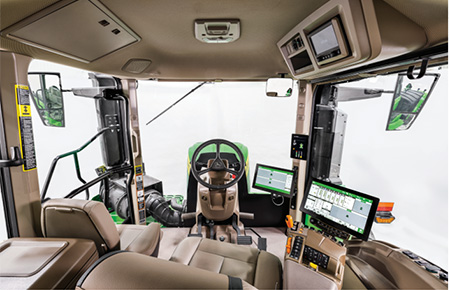 John Deere tractor paired with John Deere tool and cart
John Deere tractor paired with John Deere tool and cartWith a complete John Deere seeding solution, there are multiple different onboard and offboard technologies shown below that improve the overall seeding production step. Many of these technologies are exclusive to John Deere. Each of these technologies bring different customer value that overall lead to the ultimate John Deere seeding solution!
Improve confidence and while reducing maintenance with the new AccuRate™ metering system
- Combination of stainless steel and composite materials ensure an entire corrosion resistant system
- Individual electric meters allowing for more precise seeding
- Up to 8x more accurate prescriptions with high fidelity prescription
- Start and stop each meter with SectionCommand™ Pro
- Accurately meter the correct amount of product on a curve with curve compensation
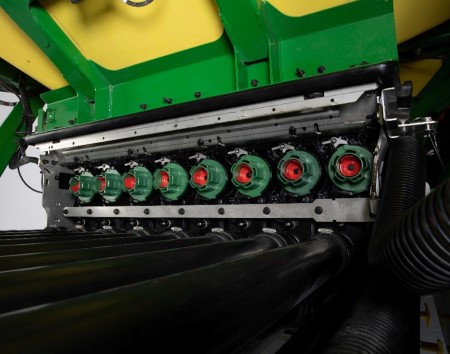 AccuRate™ meters showing eight individual sections
AccuRate™ meters showing eight individual sectionsCalibrate faster and easier than ever before with EZCal™
- Easily calibrate from the side of the cart with the click of a few buttons 45% faster than the leading competitor
- Automatically weigh product and update MDV values eliminating potential user error
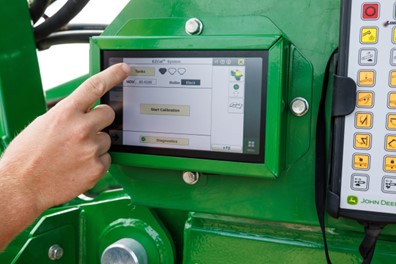 G5e Cart Side Display
G5e Cart Side Display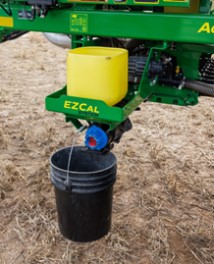 EZCal™ system
EZCal™ systemActiveCal™ display Calibrate more frequently from the seat of the cab with ActiveCal™
- Calibrate the meters from the cab utilizing the tank scales
- Improved confidence that the correct seeding rates are being met
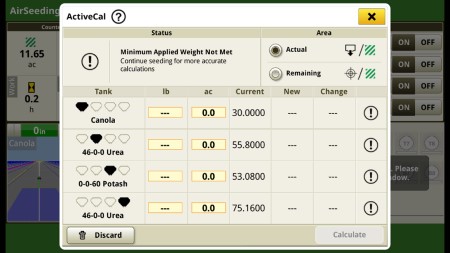 ActiveCal™ display
ActiveCal™ displaySave input cost with SectionCommand™Pro
- Control seed and fertilizer output by starting and stopping each individual meter section
- Eliminate skips and overlaps leading to reduced inputs and higher yields
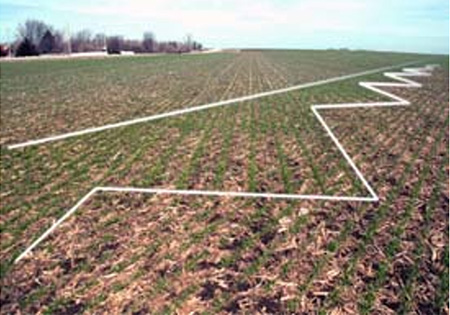 Example of seeded field with SectionCommand™ Pro
Example of seeded field with SectionCommand™ ProOn the go, quick adjust downforce with TruSet™ from the cab
- Adjust downforce pressure to improve uniform emergence
- Set presets to quickly adjust from field to field
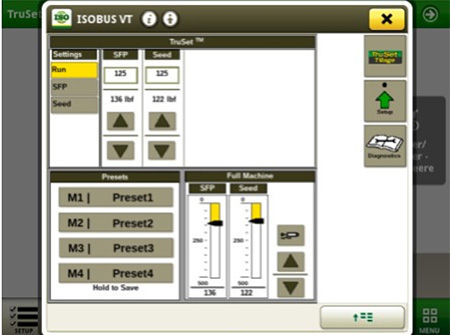 TruSet downforce display
TruSet downforce displayMonitor blockage row by row from the cab with RelativeFlow™
- Seed with confidence while monitoring each row
- Detect blockage early and know exactly where it is
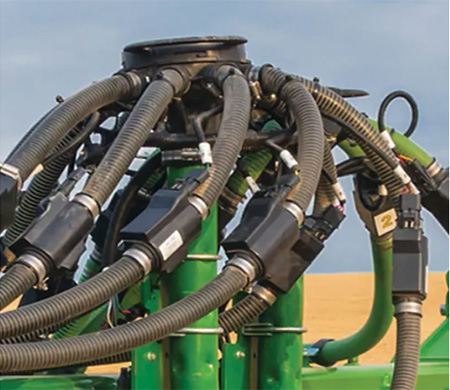 RelativeFlow blockage sensors
RelativeFlow blockage sensorsAutoTrac™ Implement Guidance and AutoTrac Turn Automation
- Make every operator an experienced operator
- Precisely placed implements for more accurate seeding, less operator fatigue, and more productivity
- Hands-free turns within field headlands (with AutoTrac Turn Automation enabled)
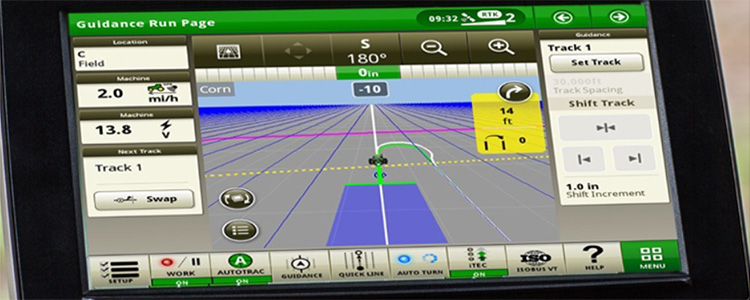 AutoTrac Turn Automation display
AutoTrac Turn Automation displayJohn Deere Operation Center™
- Setup and manage your farm operations: equipment, team, fields, and crop inputs
- Plan work in advance to increase job quality and efficiency with Work Planner
- Map based prescriptions can be used with variable rates
- Analyze this season’s results to improve next season’s crops
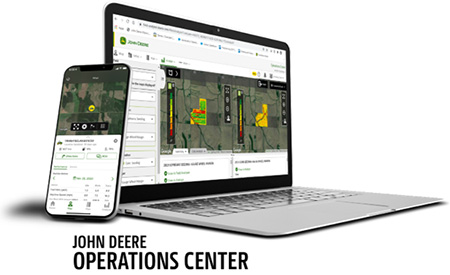 John Deere Operation Center web and mobile
John Deere Operation Center web and mobileOperation Center Mobile
- View your data on the go; remotely monitor job quality, productivity, machine performance, and quickly make informed decisions
- Manage and monitor from anywhere at any time with near real-time field and machine updates
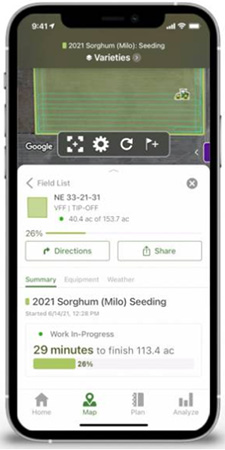 Operation Center Mobile
Operation Center MobileConnected Support
- Expert Alerts proactively notifies your dealer of any issues
- Remote display access allows for easy on the go support
 Connected Support
Connected SupportFor more information regarding Large Tractors and Precision Ag, view the following landing pages
Confidence in rates from row to row with RelativeFlow™ Blockage sensing
With RelativeFlow Blockage sensing, operators can see the flow of both seed and fertilizer from inside the tractor cab. Sensors on all secondary hoses monitor the relative product flow row to row, giving you a better view of the flow rate of both seed and fertilizer from the cart to the opener from inside your tractor cab. This technology can help you identify any problems before a potential blockage occurs.
RelativeFlow Blockage is available in all run configurations on the following models (all widths):
- H500
- H500F
- P500
- N500
- N500F
- N500C
- 730LL
RelativeFlow Blockage is compatible with hydraulic drive carts: model year 2014 and newer 1910, all 19,381.5-L (550-bu) 1910 Carts, and C650 and C850 Air Carts.
Below are the Gen 4 display screens for the blockage monitoring system. For complete details and information, see the owner’s manual.
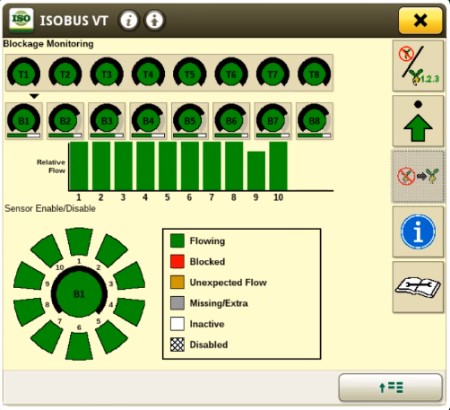 Blockage monitoring screen on Gen 4 display
Blockage monitoring screen on Gen 4 displayThe RelativeFlow Blockage sensing chart shows the amount of flow through each sensor on the selected tower. Sensitivity for the blockage system can be adjusted if desired, as shown below.
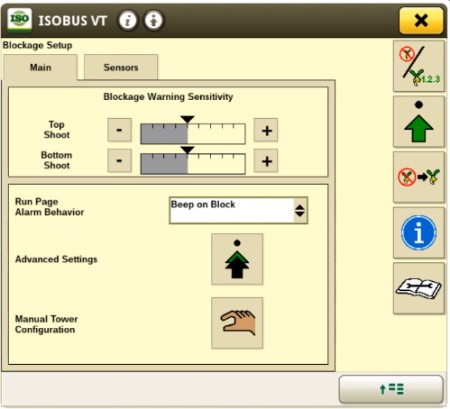 Blockage Setup screen on Gen 4 display
Blockage Setup screen on Gen 4 displayBlockage warning sensitivity allows the producer to set and change the sensitivity of the sensors to meet their preferences and varying crop/fertilizer types. Increasing the sensitivity means the system is more likely to show a false blockage, while less sensitivity means the system is more likely to miss a blockage.
Multiple run-page alarm behavior options are available for selection.
 Blockage monitoring screen on Gen 4 display
Blockage monitoring screen on Gen 4 displayBelow are the Gen 4 display screens for the blockage monitoring system on the N500C.
For complete details and information reference, the owner’s manual.
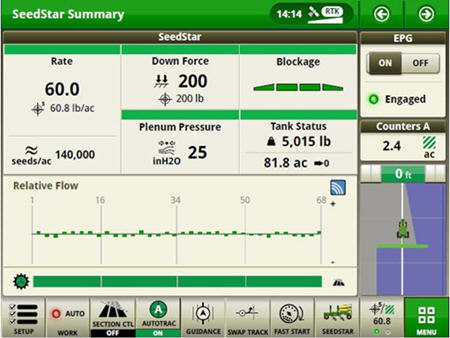 RelativeFlow Blockage configured run page
RelativeFlow Blockage configured run pageThe SeedStar™ system run page displays the five major run settings. Clicking on any of the tiles will take an operator to that specific page (shown below).
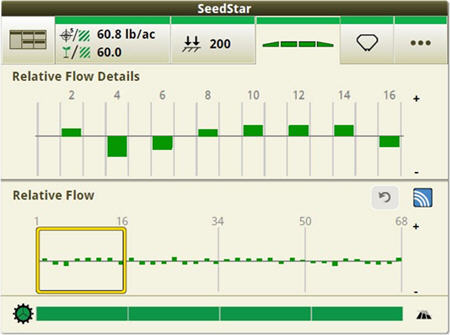 Operators can zoom into flow details by meter section when selecting blockage tiles
Operators can zoom into flow details by meter section when selecting blockage tiles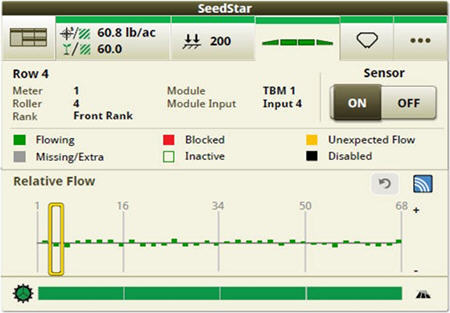 Operators can zoom into the row level to access row/sensor information and turn a sensor on/off independently
Operators can zoom into the row level to access row/sensor information and turn a sensor on/off independently Blockage sensitivities and alarm delays are all set up on one easy-to-navigate screen
Blockage sensitivities and alarm delays are all set up on one easy-to-navigate screenBlockage alarm delays can be set up by clicking on the advanced settings button from the blockage set-up screen.
- A blockage delay is how long a blockage should occur before an alarm is sounded.
- The blockage alarm reminder is how often the alarm should sound when a blockage occurs.
- The meter on delay is the time from when the meter is turned on until the blockage sensor should start monitoring for blockage.
- The meter off delay is the time from when the meter is turned off until the blockage sensor should start monitoring to verify no flow.
For more detailed information, see the owner’s manual.
Air tools with RelativeFlow Blockage are not compatible with 1910 air carts with ground drive.
Fertilizer placement
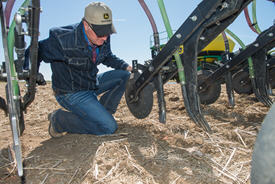
Whether using dry, liquid, or anhydrous ammonia, the John Deere P500 opener has the options that fit the application needs.
| | | | | |
| AA74478 Aqua anhydrous point | AA69276 NH3 point | AA74476 Liquid fertilizer point | AA69277 Dry fertilizer point | AA86117 Mud special point |
Description | Austempered 10B38 boron steel point with hardfaced areas and induction fused carbide inserts to prevent wear. Carbide plates are 4-mm (0.16-in.) thick along the point edge and 6-mm (0.24-in.) thick on the tip. | ||||
Application | Aqua anhydrous | Anhydrous | Liquid fertilizer | Dry fertilizer** | Dry fertilizer |
Option code | 1255 | 1250 | 1215/1220 | --- | 1235 |
Tube diameter (OD) | 9.5 mm (3/8 in.) | 12.7 mm (1/2 in.) | 6.35 mm (1/4 in.) | --- | --- |
Pin on | X | X | X | X | X |
High top | X | X | X | X | X |
Suitable for dry conditions | X | X | X | X | X |
Suitable for muddy conditions | X* | X* | X* | --- | X |
Dry fertilizer tube add-on | AA69271 | AA69271 | AA69271 | AA69266 | --- |
Weight | 0.9 kg (2 lb) | 0.97 kg (2.14 lb) | 0.88 kg (1.95 lb) | 0.86 kg (1.9 lb) | 1.7 kg (3.78 lb) |
Other information | This form of ammonia is produced by dissolving ammonia gas in water.
AA69272 hose guide is required if dry fertilizer tube is not installed. | Anhydrous ammonia is compressed into a clear, colorless liquid.
AA69272 hose guide is required if dry fertilizer tube is not installed. | AA69272 hose guide is required if dry fertilizer tube is not installed. | --- | Replaces AA69279.
Wear-resistant hardfaced welds increased by 75 percent.
Thickness increase from 4 to 8 mm (0.16 to 0.3 in.).
Extra 12.7-mm (1/2-in.) weld added close to heavy wear area. |
*If not using dry fertilizer tube add-on **Dry tube required | |||||
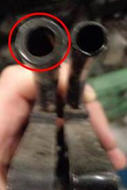 Anhydrous high top tip (left) versus aqua anhydrous tip (right)
Anhydrous high top tip (left) versus aqua anhydrous tip (right)This picture shows the difference between the anhydrous high top and aqua anhydrous tips pictured in the chart above. On the left, the anhydrous high top has a thicker tube wall (1.3-cm [0.5-in.] outer diameter) than the aqua anhydrous tip, though the inner diameter of both tips are equal. The NH3 knives may also be used in combination with the included dry-delivery tube for those wanting to apply NH3 and dry fertilizers simultaneously in the same fertilizer trench.
Additional information for code 1235: the mud-proof combination of dry-fertilizer tube and tip, code 1235, is available for those applying dry fertilizers only. This is recommended for running in sticky, heavy clay-type soils. However, it works well in all soil types to prevent mud from plugging the fertilizer tube opening. This opener is included as base equipment.
If seeding with dry fertilizer only, this option is highly recommended. The fertilizer exits the tube at a lower point, allowing growers desiring to place fertilizer at shallower depths more consistently.
The lower fertilizer exit point also allows the fertilizer to get to the bottom of the trench when more fertilizer and seed separation is desired, and for those light soils that tend to cave in the trench before the fertilizer is placed.
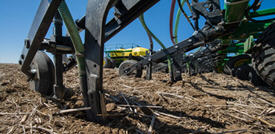 P500 fertilizer shanks engaged in the ground
P500 fertilizer shanks engaged in the ground| Fertilizer tubes | |
| 1.) AA69266 (1250) - Dry fertilizer |  |
| 2.) AA69271 (1220/50/55) - Dry fertilizer with NH3 or liquid |  |
| 3.) AA69272 (1215) - Liquid tube |  |
Row spacing options
Paired row vs. side banded
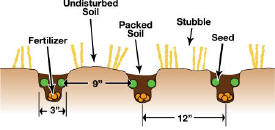 Paired row soil profile
Paired row soil profile
The P500 has two cast seed boots available. Depending on a grower’s seed and fertilizer placement preference in different soils or different crops, the P500 can meet the user’s needs. The cast opener was designed with simplicity in mind. One tube is all that is necessary. Switching from single to paired row has never been easier; simply remove the two bolts holding the cast opener in place, remove the opener, and replace with the new opener.
Paired row
With shanks on 30.5-cm (12-in.) spacing, paired rows can be planted with 22.9-cm (9-in.) spacing. Seed is banded in two rows above and to the sides of the furrow. Total tillage in this zone is 7.6-cm (3-in.) wide with about 25 percent seedbed utilization (SBU).
Seed is laid on a 2-cm (0.75-in.) shelf while fertilizer is placed in a 2.5-cm (1-in.) band between and below the two seed rows.
With paired row placement, the crop is able to access the fertilizer when it needs it. The separation is enough to safely keep the seed from burning. The P500 provides a well-prepared seedbed for quick emergence and quicker canopy, which will help eliminate weeds. If the operator is looking to swath wider rows, support the heavy green crop.
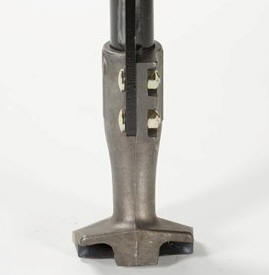 Paired row opener - rear shot
Paired row opener - rear shot Single row/side banded soil profile
Single row/side banded soil profile
Side banded
If the seeding operation calls for side banding, the P500 is the needed tool. The side-banding seed tube places the seed on a firm bed of soil above and to the side of fertilizer as required. There are 30.5-cm (12-in.) rows across the machine with positive separation between seed and fertilizer up to 11.4 cm (4.5 in.). As the seed germinates and begins to emerge, its roots will be 7.6-cm to 10.2-cm (3-in. to 4-in.) deep and into the nutrient zone.
John Deere recognizes not all seeding conditions are identical and, with the P500, offers solutions to meet seed and fertilizer placement needs.
 Single row/side banded
Single row/side banded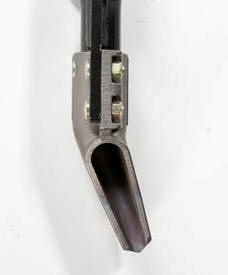 Single row/side banded - rear shot
Single row/side banded - rear shot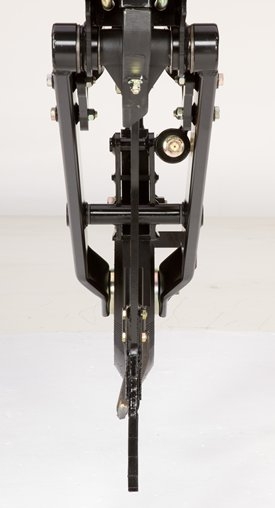 Single row seed boot in-line
Single row seed boot in-line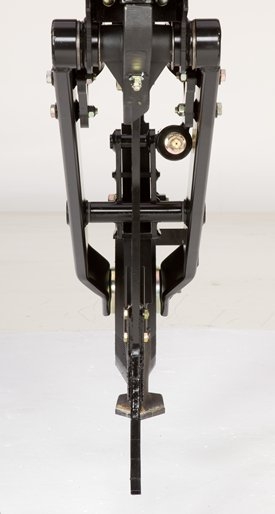 Paired row seed boot in-line
Paired row seed boot in-lineP500 vs P600? Which one is the right Precision Hoe Drill for you?
When considering a new precision hoe drill from John Deere, it is important to understand the differences between the P500 and the P600. There are key differences in the two openers that are outlined below. Understanding the differences will help the customer have the best performance for their exact situation.
| P500 | P600 |
Opener type | Paired row – side band Single row – side band | Dual knife – side band In-line knife – side band |
Seed to fertilizer horizontal separation | 3.8 cm (1.5 in.) consistent separation | 3.8 cm (1.5 in.) consistent separation |
Seed to fertilizer vertical separation | Adjustable up to 11.4 cm (4.5 in.) | 1.9 cm (0.75 in.) consistent separation |
HP per opener required | 6 HP | 5 HP |
Available row spacing | 9 in. paired rows and 12 in. single row | 10 in. and 12 in. |
Working widths available | 40 ft and 56 ft | 60 ft, 70 ft, 80 ft, and 90 ft |
RelativeFlow™ available | Yes | Yes |
TruSet™ available | No | Yes |
Agronomic value |
|
|
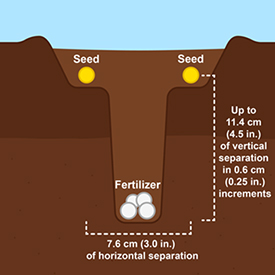 P500 paired row separation
P500 paired row separation P500 single row separation
P500 single row separation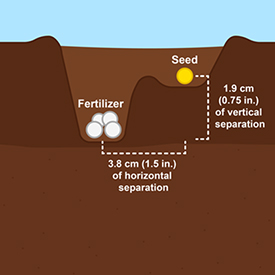 P600 dual knife separation
P600 dual knife separation P600 in-line knife separation
P600 in-line knife separationJohn Deere Seeding cover crop solutions
Why cover crops?
With proper management and the right selection of cover crops, you can slow soil erosion, improve soil health, enhance water availability, suppress weeds, control pests and diseases, increase biodiversity, and reap numerous other benefits for your farm’s health and profitability. Cover crops act as a protective shield for the soil, reducing the impact of heavy rains and wind, which in turn minimizes topsoil loss. They improve soil structure by adding organic matter and fostering beneficial soil microorganisms, which enhances nutrient cycling and retention.
Additionally, cover crops can break up compacted soil layers, improving root penetration and water infiltration. By suppressing weeds, they reduce the need for chemical herbicides, leading to more sustainable farming practices. Cover crops also provide beneficial habitat for insects and pollinators, boosting on-farm biodiversity. Furthermore, they can help in sequestering carbon, contributing to climate change mitigation. Overall, integrating cover crops into your farming system can lead to more resilient and productive agricultural landscapes, ultimately enhancing long-term profitability.
What tool works best for you?
 N500C No-Till Air Drill
N500C No-Till Air DrillThe N500C model machines provide extensive crop compatibility, making them an excellent choice for customers looking to seed multiple crops and crop blends using a single tool. These machines can be customized with two unique rollers in multiple sizes to meet the specific needs of each operation. Refer to the crop compatibility link by roller below. Additionally, the N500C is capable of seeding in various soil conditions and residue types. Featuring the Pro-Series No-Till opener, it is designed to handle a wide range of conditions, from heavy residue to lightly worked soils. For more information, see the Sales Manual links below.
 1590 No-Till Box Drills
1590 No-Till Box DrillsBox Drills are an excellent choice for seeding cover crops, offering simplicity and high placement accuracy. Equipped with the Pro-Series No-Till opener, the 1590 Box Drill can handle a variety of conditions, from heavy residue to lightly worked soils. The 455 and BD11 Series Box Drills, featuring a double disk opener, are ideal for tilled seed beds. They also provide wider widths and a range of spacing options. For more information, see the Sales Manual link below.
Already have an Air Seeder?
 C-Series Air Cart tendering
C-Series Air Cart tenderingAny John Deere air cart compatible tools are excellent options for seeding cover crops. Air carts come with multiple tanks, enabling you to combine or blend your cover crop mixes effectively. With a wide range of meter roller options, air carts can be easily tailored to meet your specific cover crop needs and paired with the most suitable tool for the job. For more information, see the Sales Manual links below.






